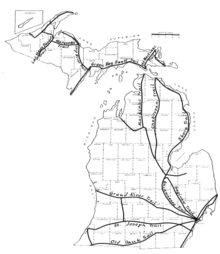Sauk Trail

The Sauk Trail began as a Native American trail running through Illinois, Indiana and Michigan in the United States. From west to east, the trail ran from Rock Island on the Mississippi River to the Illinois River near modern Peru then along the north bank of that river to Joliet, and on to Valparaiso, Indiana. Then it ran northeasterly to La Porte and into southern Michigan running through Niles, Three Rivers, Ypsilanti, and ending at the Detroit River near Detroit.[1] There is a suggestion that sections of the trail followed the southern boundary between the dense forest and the mixed grassland regions. The presence of a mastodon trailway along the same path indicates that the Native Americans may have been using a long established game trail.[2] Henry Schoolcraft, at present-day Michigan City, Indiana, in 1820, describes the trail, as a "plain horse path, which is considerably traveled by traders, hunters, and others..." and said that a stranger could not follow it without the services of a guide because of the numerous side trails.[3] The Sauk Trail intersected many important trails and early roads including the trails to Vincennes, to Green Bay, to Fort Wayne and to Little Traverse Bay.[3]
Illinois
In Illinois, not much is known about the exact path, but it is reasonable to say that the path may have followed the same general path as U.S. Route 6 (US 6), which winds its way from Rock Island, to Peru, near the Illinois River, and past what was at one point, the "Grand Village of the Illini", near current day Utica, and it follows along the northern bank of the Illinois River to Joliet. Settler accounts note that where the Rock River joined the Mississippi River was the beginning of a native path that continued eastwards to Chicago. Further, US 6, via 159th street and then 9th and 10th streets eventually links to US 12 which is a known portion of the Sauk Trail that ultimately ends in Detroit. Additionally, US 6 parallels, at various points, the Illinois and Des Plaines rivers' paths, and some of their tributaries. River banks were commonly used as native pathways. Another possibility, although unlikely, could be the current path of Interstate 80, as it runs through the same general area and follows a similar path as US 6.
Michigan
In Michigan, the trail has been associated with the route of the modern US Highway 12 since 1962; before that year, it was US 112.
See also
- Saginaw Trail, another trail named after the Sac
References
- ↑ Forest Preserve District of Cook County (December 4, 1971). "Old Sauk Trail". Forest Preserve District of Cook County. Nature Bulletin No. 436-A.
- ↑ "US 12 Heritage Trail, Western Tour" (PDF). US 12 Heritage Trail. 2007.
- 1 2 Quaife, Milo M. (1923). Chicago's Highways Old and New From Indian Trail to Motor Road. Chicago: D. F. Keller & Company.
External links
-
 Media related to Sauk Trail at Wikimedia Commons
Media related to Sauk Trail at Wikimedia Commons